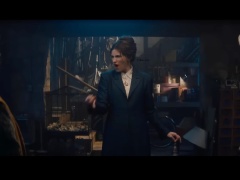
The best received of Spanish series at last month’s Málaga Festival, “Nights in Tefía” (“Las Noches de Tefía”) hit the festival with already strong buzz. The latest from Spain’s Buendía Estudios and SVOD service Atresplayer Premium whose titles also include “Veneno” and “Cardo,” “Nights in Tefía” proved a critics’ favourite. Written and directed by Miguel del Arco, a distinguished Spanish playwright and theater director, it turns on Airam Betancor who, living in Tenerife in 2004, recognises an old man shuffling down the street: Robles.
He’s the same man who, 42 years before, as a prison guard at the euphemistically named Tefía Penitentiary Agricultural colony on Fuerteventura, another Canary Island, had beaten and tortured Airam as a teen inmate of the Francoist labor camp designed as a dumping ground for undesirables, from political dissidents to the socially unruly and homosexuals.
The sight of Robles, who has moved into Airam’s neighborhoodto live with his daughter’s family, sparks in Airam nightmares of his time at Tefía, where he was subjected to forced labor as a daily quarry worker, beaten and raped and falls in love with the bravest and most rebellious of the inmates, the unrepentant homosexual Flores (a tearaway performance by Patrick Criado). But he also remembers how his time there was made bearable, by nightly tales imagined by another inmate, a bohemian theater director, nicknamed Seriales, set at the fictitious Tindaya, the most famous music hall in the capital where every inmate has an alter ego, Airam as a costume designer.
“Nights in Tefía” turns on repression: Franco regime’s whose brutal concentration camps are little commented on, even today in Spain; Airam’s, who denies the deep traumas Tefía has left on him, or his true being; and Spain’s, whose left has had to battle to expose the crimes against humanity under Franco, which much of the country would prefer to sweep under the carpet.
PvNewchatted with Del Arco in the run-up to MipTV where “Nights in Tefía” will be brought onto the international market by Atresmedia TV International Sales.
In 2019, Spanish historian Carlos Hernández de Miguel published a 556-page book detailing 300 concentration camps created by Franco’s regime. He also observed that “statistics are necessary but don’t make real sense unless we’re able to understand that behind every figure there were thousands of men, women and families.” Your series goes one step further through fiction’s marvellous capacity to create empathy, allowing viewers to feel what victims felt and sense their humanity…..
In a way, that’s the thesis of the series, it’s a fiction that can cure us, which creates an emotional connection with the victims. Newsreels just create a kind of anaesthesia. You’re told 30 immigrants have drowned in the Mediterranean, and think ‘what a shame’ and go on eating.
A dissident under Stalin, Anna Akhmatova I think, wrote that the only form of resistance to Stalin was the imagination. Did you discover real cases of prisoners creating anything comparable to Tindaya?
Not any specific cases, but the imagination has been a constant as one of the principal arms of resistance. Victims of terrible institutions attempt a kind of distance. I wanted the humor, which the camp prisoners use to survive, to create a special empathy with viewers. The challenge was not to fall into frivolity, or comic farce. But humor, the more the more terrible the situation, was absolutely necessary.
One of the most impactful decisions you take is to shoot the real past in B&W, the 2004 present in color and Tindaya in a glitzier color. Yet there’s a certain sense of darkness to the Tindaya sequences and color tones in 2004 scenes have a certain ordinariness to them….
Those were choices we made when we selected the camera and lensed we were going to use for each world. There had to be a relation between the screenplay’s darkness and Tindaya, that its colors didn’t pop on the screen. We used flyers to taper the luminosity of the Canary Islands so that the 2004 scenes weren’t too sugar-coated.
The series turns on repression: Franco’s regime’s, Airam’s, Spain’s….
We are all narratives, we narrate ourselves, our partner, we settle into a fiction that we try to make fit with the life we want. Such is the horror of the concentration camp in who ch he spends 17 months that Airam invents himself, his life, which has nothing to do with his true being until 40 years later, he sees again a face that he hardly recognises but which awakens a dormant narrative. It awakens as well when he begins to talk to the documentary filmmaker who tells him that he’s not interested in Tindaya and should stick to the facts. To which Airam replies with a certain irony that remembering back he doesn’t know what is more important, the fiction in the past or the reality.
And how does this play out?
There’s a twist in Episode 6 which underscores how what we believe we are is a fictional narrative and how a historical memory [as a country] is absolutely necessary to be able to narrate and construct a country. Spain has been built on the fiction of an exemplary transition [from dictatorship to democracy] and it was really a transition of oblivion. We attempted to make a fresh start to be able to go on subsisting without facing up to the events that have shaped this country.






